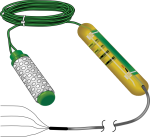
No maintenance required






Overview
The 229 is a sensor that measures soil water potential from -10 to -2500 kPa. It requires that you connect it to either the CE4 or CE8 current excitation module. A Campbell Scientific data logger controls the current excitation module, measures the sensor, and calculates soil water matric potential.
Read MoreBenefits and Features
- Compatible with most Campbell Scientific data loggers
- Measures a wide range of matric potential
- Measurements not affected by salts in the soil
- Long lasting, with no maintenance required
- Compatible with AM16/32-series multiplexers, allowing measurement of multiple sensors
The "-L" on a product model indicates that the cable length is specified at the time of order.
Images




Similar Products
Detailed Description
The 229 Water Matric Potential Sensor consists of a heating element and thermocouple placed in epoxy in a hypodermic needle, which is encased in a porous ceramic matrix.
To calculate soil water matric potential, a CE4 or CE8 current excitation module applies a 50 mA current to the 229's heating element, and the 229's thermocouple measures the temperature rise. The magnitude of the temperature rise varies according to the amount of water in the porous ceramic matrix, which changes as the surrounding soil wets and dries. Soil water matric potential is determined by applying a second-order polynomial equation to the temperature rise. Users must individually calibrate each of their 229 sensors in the soil type in which the sensors will reside.
A reference temperature measurement is required for the 229’s thermocouple measurement. Options for measuring the reference temperature include:
- Thermistor built into the CR6, CR800, CR850, CR1000, CR3000, or CR5000 wiring panel
- PRT built into the wiring panel of the CR9050 or CR9051E input module for the CR9000X Measurement and Control System
Specifications
| Operating Temperature Range | -5° to +30°C |
| Normal Environmental Temperature Range | -40° to +70°C |
| Measurement Range | -10 to -2500 kPa |
| Measurement Time | 30 s (typical) |
| Thermocouple Type | Copper/constantan (type T) |
| Heater Resistance | ~34 Ω |
| Resolution | ~1 kPa (at matric potentials < -100 kPa) |
| Diameter | 1.5 cm (0.6 in.) |
| Length | 6.0 cm (2.4 in.) |
| Cable Weight | ~23 g/m (0.25 oz/ft) |
| Sensor Weight | 10 g (0.35 oz) |
Compatibility
Note: The following shows notable compatibility information. It is not a comprehensive list of all compatible or incompatible products.
Data Loggers
| Product | Compatible | Note |
|---|---|---|
| CR1000 (retired) | ||
| CR1000X (retired) | ||
| CR300 (retired) | ||
| CR3000 (retired) | ||
| CR310 | ||
| CR350 | ||
| CR6 | ||
| CR800 (retired) | ||
| CR850 (retired) |
Additional Compatibility Information
Current Excitation Modules
Either a CE4 or CE8 current excitation module is required to provide a constant current to the heating element of the 229. The CE4 and CE8 differ only in the number of 229 sensors to which they source current. The CE4 sources current for up to four 229s, and the CE8 sources current for up to eight. Both modules require a 12 Vdc power source.
Multiplexers
In applications that require more sensors, the output(s) of the CE4 or CE8 can be connected to as many AM16/32-series multiplexers as there are outputs, greatly expanding system capacity. If using multiplexers, the user should be aware that switching currents of greater than 30 mA will degrade the contact surfaces of the mechanical relays. Therefore the data logger should be programmed to turn off the current excitation module before switching multiplexer channels in order to protect the multiplexer relays.
Data Logger Considerations
One differential channel and one current excitation channel per probe are required. Each CE4 or CE8 current excitation module requires one data logger control port.
Programming
The 229 is measured by a sequence of data logger instructions where the thermocouple is measured at 0 s, 1 s, and 30 s, while a 50 mA current is applied to the heating element. This current is supplied by the CE4 or CE8 current excitation module. The rise in temperature during heating is related to the soil water matric potential.
Reference Temperature Measurement
A reference temperature measurement is required. Options for measuring the reference temperature include:
- Thermistor built into the CR800, CR850, CR1000, CR3000, or CR5000 wiring panel
- PRT built into the wiring panel of the CR9050 or
- CR9051E input module for the CR9000X Measurement and Control Datalogger
- PRT built into the wiring panel of the CR723T input card for the CR7 Measurement and Control Datalogger
- CR10XTCR thermistor that connects to the CR10X wiring panel
Documents
Frequently Asked Questions
Number of FAQs related to 229-L: 11
Expand AllCollapse All
Case Studies
Chevron Mining, Inc., (CMI) owned and operated a 6.6 million-metric-ton-per-year (6.6 million-U.S.-ton) molybdenum mining and......read more
Acid Rock Drainage (ARD) problems associated with hard rock metal mining are one of the......read more
Privacy Policy Update
We've updated our privacy policy. Learn More
Cookie Consent
Update your cookie preferences. Update Cookie Preferences


